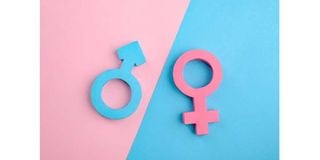Put more funds into gender equity

Gender equality symbol. The Constitution provides that no more than two-thirds of the members in any elective or appointive positions shall be of the same gender.
What you need to know:
- Newspapers reported numerous cases of incest and teenage pregnancies over this period, meaning many cases will have gone unreported.
- Of grave concern was the revelation that only 0.3 per cent of Kenya’s national budget is allocated to gender while 13 out of 47 counties—27.7 per cent of the devolved units—allocate zero to gender!
The UN Women Kenya Country office recently released a strategic note (known as strategic plan in common parlance) which makes for sober reading.
The launch, at Villa Rosa Kempinski, off Waiyaki Way, in Nairobi, was presided over by Country Director Anna Mutavati, flanked by various programme leads.
Of grave concern was the revelation that only 0.3 per cent of Kenya’s national budget is allocated to gender while 13 out of 47 counties—27.7 per cent of the devolved units—allocate zero to gender!
Even where “Strategic Note 2023-2026” seems to shine a ray of hope, the overall statistics offer little to celebrate, with democratic governance as a case in point.
The strategy takes cognisance of the fact that the number of elected women governors more than doubled—from three to seven from 2017 to 2022.
While ‘more than double’ is statistically correct and points to a huge success, it pales against the fact that it adds up to a mere 14.9 per cent of the 47 governors in the country vis-à-vis the two-thirds gender rule.
The Constitution provides that no more than two-thirds of the members in any elective or appointive positions shall be of the same gender.
In regard to the governors, a whopping 85.1 per cent of them are men—almost 20 per cent above the constitutional threshold of 66.6 per cent.
And unlike MPs and members of the county assembly (MCAs), whose membership can be beefed up through nominations, that does not apply to governors, a cadre that wields great clout in county governance. It makes the ‘more than double’ significance mere semantics and of little consequence.
The same concern applies to the number of women elected to Parliament, which increased to 23.5 per cent in the 2017 General Election—a mere 1.5 per cent in the 2022 polls.
This is not to belittle the work of the United Nations Entity for Gender Equality and the Empowerment of Women (the full name of UN Women). Rather, it’s to underline the mammoth task of the realisation of gender equity in Kenya. It’s about pointing out and removing the hurdles in the way of gender equity and women’s empowerment, a key plank in the strategic note.
So what are these hurdles? The strategic note is not oblivious to these and, indeed, lists ending violence against women as a critical aspect of its agenda. It further states that “fewer women and girls reported experiencing violence”.
Discordance
According to the report, the number of women and girls reporting physical violence dropped by four per cent from 20 per cent in 2014. Cases of sexual violence dropped from 7.6 per cent to 6.42 per cent and reporting of female genital cutting fell by a whopping 23 per cent—from 38 per cent in 2014 to 15 per cent in 2022.
Viewed against the underperformance in governance, a question arises. First is the discordance between the steep drop in cases of violence across the board vis-à-vis the negligible increase in the number of elected women in governance positions.
Does it mean that cases of violence decreased or there was less reporting of such incidents? Notably, the reporting period (2014-22) coincided with the Covid-19 lockdown (2020-22).
Newspapers reported numerous cases of incest and teenage pregnancies over this period, meaning many cases will have gone unreported.
Therefore, despite the 40 per cent increase in resolving of gender-based violence (GBV) cases through the justice system—from 6,043 to 8,489 over the 2020-22 period, according to the State of the Judiciary and Administration of Justice Reports—the data call for interrogation.
Indeed, at the prelaunch media briefing of Strategic Note 2023-2026 at the same venue, which was well attended by mainstream and freelance journalists, a participant, Ms Dorcas Odumbe, Partnerships Manager and Gender Editor at Nation Media Group, expressed her concern at the performance of data desks. It was clear from the figures that they painted a rosier picture than the reality on the ground.
Session moderator and Africa Women and Child Feature Service director Arthur Okwemba underlined the need to hold duty bearers to account in matters of gender equity and women’s empowerment.
Strategic Note 2023-26 has a galaxy of funders, including the United Nations Development Programme (UNDP), the European Union, the Foreign Commonwealth and Development Office and Japanese, Irish, German and Italian agencies, working with UN Women Kenya to realise its goals. Top-most is enhancing women’s participation in leadership and decision-making.
Translating statistics into reality will require partners to focus more on UN Women’s role in ensuring national and county plans and budgets allocate resources to gender equality efforts. Having 13 of 47 counties give zero to gender is untenable.
Ms Kweyu is a consulting editor. [email protected].





